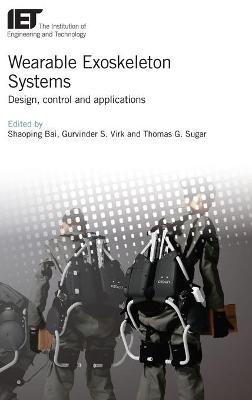
Wearable Exoskeleton Systems
Institution of Engineering and Technology (Verlag)
978-1-78561-302-9 (ISBN)
In this book, the editors and authors report recent advances and technology breakthroughs in exoskeleton developments. It will be of interest to engineers and researchers in academia and industry as well as manufacturing companies interested in developing new markets in wearable exoskeleton robotics.
Shaoping Bai is an Associate Professor at the Department of Mechanical and Manufacturing Engineering, Aalborg University, Denmark. His research interests include dynamics and design, assistive exoskeletons, parallel manipulators, and walking robots. He holds a Ph.D. degree in Robotics from Nanyang Technological University, Singapore. Gurvinder Singh Virk is Technical Director at InnotecUK involved in designing and commercialising specialised robotic systems for hazardous environments and service robots for healthcare. His current interests are in wearable exoskeletons; climbing and walking robots, and robot safety standardisation. He has been awarded the Freedom of the City of London for his work and holds a PhD in Control theory from Imperial College, University of London, UK. He has held Professorship positions at several universities in UK, New Zealand, Germany, China, India and Sweden. Thomas Sugar is Professor in the Department of Engineering, The Polytechnic School, Ira A. Fulton Schools of Engineering, Arizona State University, USA. He works in the areas of wearable robotics for rehabilitation, gait assistance and enhanced mobility. He holds a PhD in Mechanical Engineering and Applied Mechanics from the University of Pennsylvania, USA.
Section 1: Review and overall requirements
Chapter 1: Lower-limb wearable robotics
Chapter 2: Review of exoskeletons for medical and service applications: ongoing research in Europe on wearable robots, with focus on lower extremity exoskeletons
Chapter 3: Soft wearable robots
Chapter 4: Exploring user requirements for a lower body soft exoskeleton to assist mobility
Section 2: Design and control of exoskeletons
Chapter 5: Design and control of spherical shoulder exoskeletons for assistive applications
Chapter 6: Calibration platform for wearable 3D motion sensors
Chapter 7: Control and performance of upper- and lower extremity SEA-based exoskeletons
Chapter 8: Gait-event-based synchronization and control of a compact portable knee-ankle-foot exoskeleton robot for gait rehabilitation
Section 3: Devices
Chapter 9: Real-time gait planning for a lower limb exoskeleton robot
Chapter 10: Soft wearable assistive robotics: exosuits and supernumerary limbs
Chapter 11: Walking assistive apparatus for gait training patients and promotion exercise of the elderly
Section 4: Commercialization issues
Chapter 12: Regulatory issues for exoskeletons
Chapter 13: Test methods for exoskeletons - lessons learned from industrial and response robotics
Chapter 14: Ekso Bionics
| Erscheinungsdatum | 23.07.2018 |
|---|---|
| Reihe/Serie | Control, Robotics and Sensors |
| Verlagsort | Stevenage |
| Sprache | englisch |
| Maße | 156 x 234 mm |
| Themenwelt | Informatik ► Theorie / Studium ► Künstliche Intelligenz / Robotik |
| Technik ► Maschinenbau | |
| ISBN-10 | 1-78561-302-2 / 1785613022 |
| ISBN-13 | 978-1-78561-302-9 / 9781785613029 |
| Zustand | Neuware |
| Haben Sie eine Frage zum Produkt? |
aus dem Bereich


